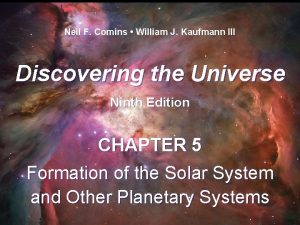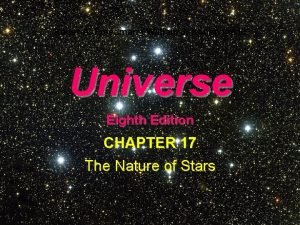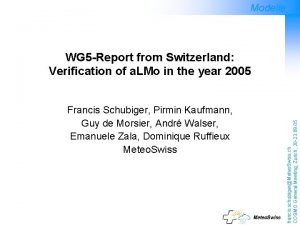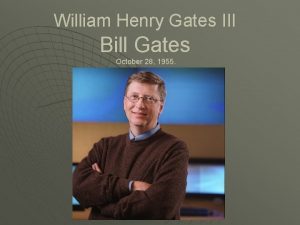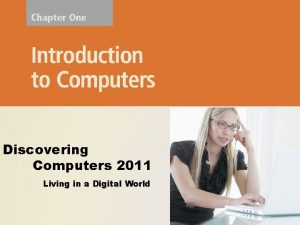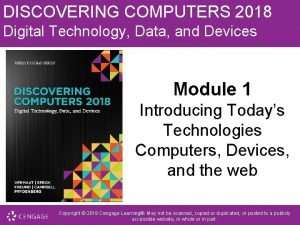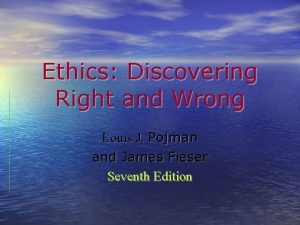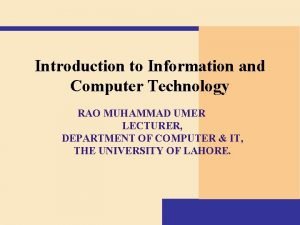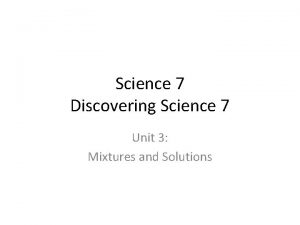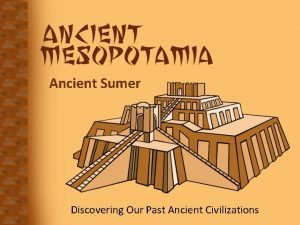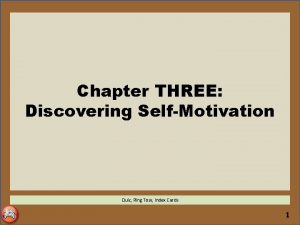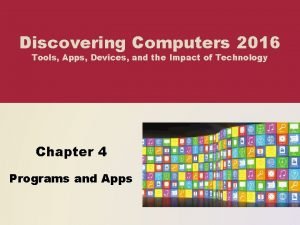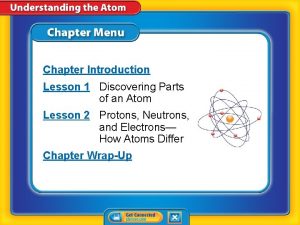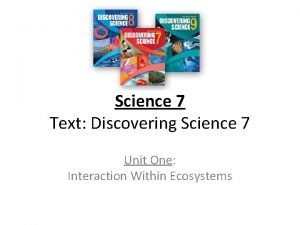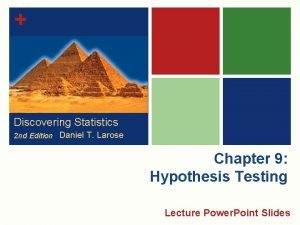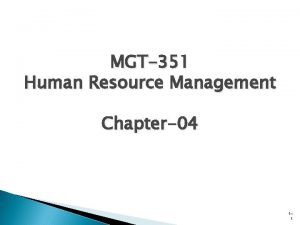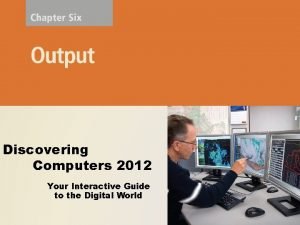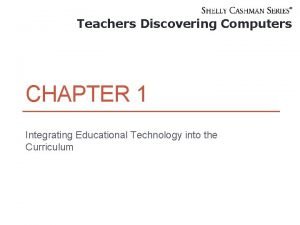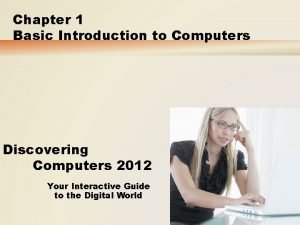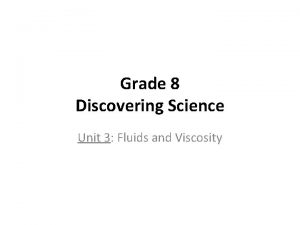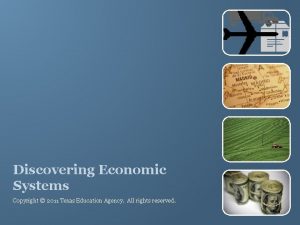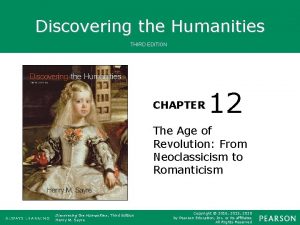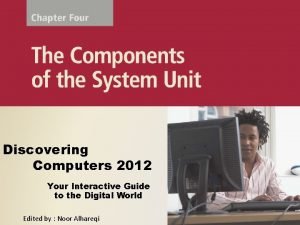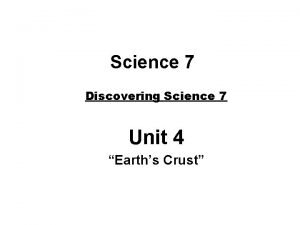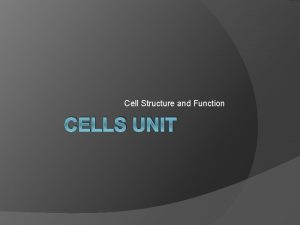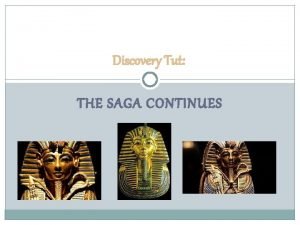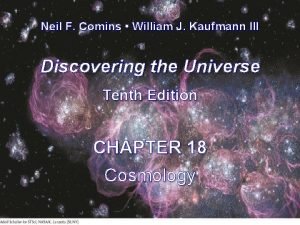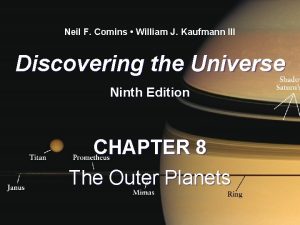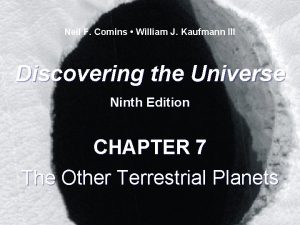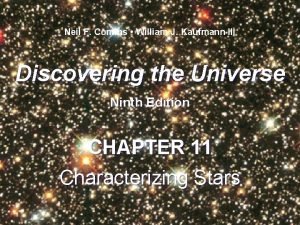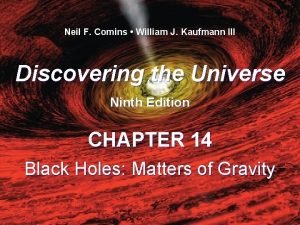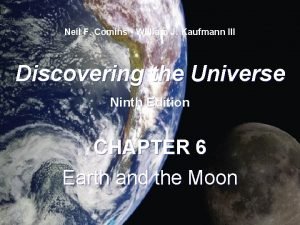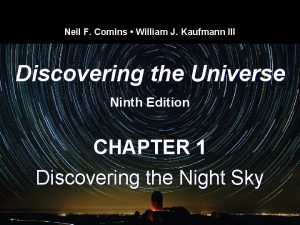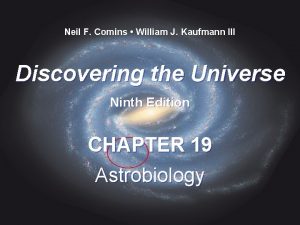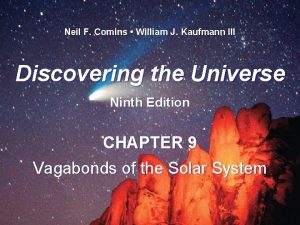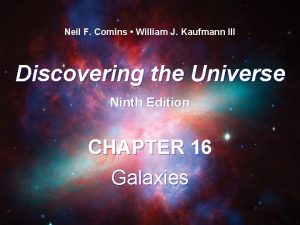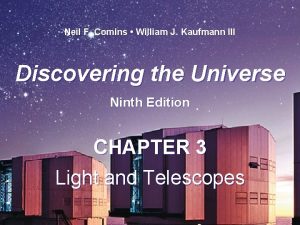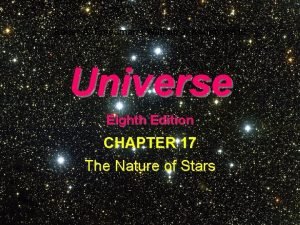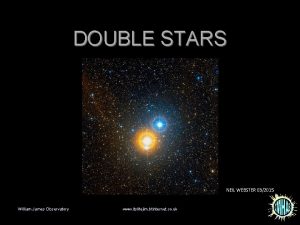Neil F Comins William J Kaufmann III Discovering











































- Slides: 43

Neil F. Comins • William J. Kaufmann III Discovering the Universe Tenth Edition CHAPTER 2 Gravitation and the Motion of the Planets

In this chapter you will discover… l l l what makes a theory scientific the scientific discoveries that revealed that Earth is not at the center of the universe, as previously believed Copernicus’s argument that the planets orbit the Sun why the direction of motion of each planet on the celestial sphere sometimes changes that Kepler’s determination of the shapes and other properties of planetary orbits depended on the careful observations of his mentor Tycho Brahe how Isaac Newton formulated an equation to describe the force of gravity and how he thereby explained why the planets and moons remain in orbit

The Scientific Method The scientific method is used to develop new scientific theories. Scientific theories are accepted when they make testable predictions that can be verified using new observations and experiments.

Science is both a body of knowledge and a process of learning about nature l l l The scientific method is a process by which scientists study nature and develop new scientific theories. A scientific theory must be testable, that is, capable of being disproved. Theories are tested and verified by observation or experimentation and result in a process that often leads to their refinement or replacement and to the progress of science. Observations of the cosmos have led astronomers to discover some fundamental physical laws of the universe. The scientific method can be summarized by the following words: observe, hypothesize, predict, test, modify, and simplify

Paths of Mars The retrograde motion of Mars as it would be seen in a series of images taken on the same photographic plate.

Paths of Mars (b) To help visualize this motion on the celestial sphere, astronomers often plot the position of Mars (or other body in retrograde motion) on a star chart. The retrograde path is sometimes a loop north, as shown in (a) and (b), or south of the normal path, and sometimes an S-shaped path across the ecliptic. (c) In the middle of 2016, Mars will undergo an S-shaped retrograde motion.

A Geocentric Explanation of Planetary Motion Each planet revolves around an epicycle, which in turn revolves around a deferent centered approximately on Earth. As seen from Earth, the speed of the planet on the epicycle alternately (a) adds to or (b) subtracts from the speed of the epicycle on the deferent, thus producing alternating periods of direct and retrograde motions.

Ptolemy and Retrograde Motion l l The geocentric (Earth-centered) solar system model emerged because one could not feel the Earth move under them, and objects in the sky appeared to move past the observer. Ptolemy explained retrograde motion using epicycles around a larger circle (deferent) with unprecedented accuracy. Eventually, adjustments had to be made and astronomers realized they needed a new theory.

A Heliocentric Explanation of Retrograde Motion Earth travels around the Sun more rapidly than does Mars. Consequently, as Earth overtakes and passes this slowermoving planet, Mars appears (from points 4 through 6) to move backward among the background stars for a few months.

Nicolaus Copernicus (1473– 1543) Copernicus, the youngest of four children, was born in Torun, Poland. He pursued his higher education in Italy, where he received a doctorate in canon law and studied medicine. Copernicus developed a heliocentric theory of the known universe and just before his death in 1543 published this work under the title De Revolutionibus Orbium Coelestium. His revolutionary theory was flawed in that he assumed that the planets had circular orbits around the Sun. This was corrected by Johannes Kepler.

Tycho Brahe (1546– 1601) Tycho (depicted to the right and within the portrait of Kepler) was born to nobility in the Danish city of Knudstrup, which is now part of Sweden. At age 20, he lost part of his nose in a duel and wore a metal replacement thereafter. In 1576, the Danish king Frederick II built Tycho an astronomical observatory that Tycho named Uraniborg (after Urania, Greek muse of astronomy). Tycho rejected both Copernicus’s heliocentric theory and the Ptolemaic geocentric system. He devised a halfway theory called the Tychonic system. According to Tycho’s theory, Earth is stationary, with the Sun and the Moon revolving around it, while all the other planets revolve around the Sun.

Johannes Kepler (1571– 1630) Kepler was educated in Germany, where he spent 3 years studying mathematics, philosophy, and theology. In 1596, Kepler published a booklet in which he attempted to mathematically predict the planetary orbits. Although his theory was altogether wrong, its boldness and originality attracted the attention of Tycho Brahe, whose staff Kepler joined in 1600. Kepler deduced his three laws from Tycho’s observations.

Galileo Galilei (1564– 1642) Born in Pisa, Italy, Galileo studied medicine and philosophy at the University of Pisa. He abandoned medicine in favor of mathematics. He held the chair of mathematics at the University of Padua, and eventually returned to the University of Pisa as a professor of mathematics. There Galileo formulated his famous law of falling bodies: All objects fall with the same acceleration regardless of their weight. In 1609 he constructed a telescope and made a host of discoveries that contradicted the teachings of Aristotle and the Roman Catholic Church. He summed up his life’s work on motion, acceleration, and gravity in the book Dialogues Concerning the Two Chief World Systems, published in 1632.

Isaac Newton (1642– 1727) Newton delighted in constructing mechanical devices, such as sundials, model windmills, a water clock, and a mechanical carriage. He received a bachelor’s degree in 1665 from the University of Cambridge. While there, he began developing the mathematics that later became calculus (developed independently by the German philosopher and mathematician Gottfried Leibniz, 1646– 1716). While pursuing experiments in optics, Newton constructed a reflecting telescope and also discovered that white light is actually a mixture of all colors. His major work on forces and gravitation was the tome Philosophiae Naturalis Principia Mathematica, which appeared in 1687. In 1704, Newton published his second great treatise, Opticks, in which he described his experiments and theories about light and color. Upon his death in 1727, Newton was buried in Westminster Abbey, the first scientist to be so honored.

Planetary Configurations We define special positions of the planets in their orbits depending upon where they appear in our sky. For example, while at a conjunction, a planet will appear in the same part of the sky as the Sun, while at opposition, a planet will appear opposite the Sun in our sky.

Synodic Period The time between consecutive conjunctions of Earth and Mercury is 116 days. As is typical of synodic periods for all planets, the location of Earth is different at the beginning and end of the period because it orbits around the Sun as well as the planet. You can visualize the synodic periods of the outer planets by putting Earth in Mercury’s place in this figure and putting one of the outer planets in Earth’s place.

Parallax Nearby objects are viewed at different angles from different places, an effect called parallax. These objects also appear to be in different places with respect to more distant objects when viewed by observers located at different positions. Parallax is used by astronomers, surveyors, and sailors to determine distances.

The Parallax of a Nearby Object in Space Tycho thought that Earth does not rotate and that the stars revolve around it. From our modern perspective, the changing position of the supernova would be due to Earth’s rotation as shown. (a) Tycho argued that if an object is near Earth, its position relative to the background stars should change over the course of a night. (b) Tycho failed to measure such changes for the supernova in 1572. This is illustrated in (b) by the two telescopes being parallel to each other. He therefore concluded that the object was far from Earth.

Ellipses An ellipse can be drawn with a pencil, a loop of string, and two thumbtacks, as shown. If the string is kept taut, the pencil traces out an ellipse. The two thumbtacks are located at the two foci of the ellipse.

Ellipses The amount of elongation in a planet’s orbit is defined as its orbital eccentricity (e). An orbital eccentricity of 0 is a perfect circle, while an eccentricity close to 1. 0 is nearly a straight line. In an elliptical orbit, the distance from a planet to the Sun varies. The point in a planet’s orbit closest to the Sun is called perihelion and the point in a planet’s orbit farthest from the Sun is called aphelion.

Ellipses Mercury has an especially eccentric orbit around the Sun. As seen from Earth, the angle of Mercury at greatest elongation ranges from 18° to 28°. In contrast, Venus’s orbit is nearly circular, with both greatest elongations of 47°.

Kepler’s First and Second Laws Kepler’s first law: The orbit of a planet about the Sun is an ellipse with the Sun at one focus. Kepler’s second law: A line joining the planet and the Sun sweeps out equal areas in equal intervals of time.

Kepler’s Third Law The square of a planet’s sidereal period around the Sun is directly proportional to the cube of the length of its orbit’s semimajor axis. P 2 = a 3 l This equation says that a planet closer to the Sun has a shorter year than does a planet farther from the Sun. In other words planets closer to the Sun move more rapidly than those farther away. l


Units of Astronomical Distance Astronomical Unit (AU) is the average distance from Earth to the Sun, about 1. 5 x 108 km (9. 3 x 107 mi). l Light year (ly) is the distance light travels in one year through a vacuum: 9. 46 x 1012 km or 63, 200 AU. l Parsec as shown in the following diagram: 3. 09 x 1013 km or 3. 26 ly. l

A Parsec The parsec, a unit of length commonly used by astronomers, is equal to 3. 26 ly. The parsec is defined as the distance at which 1 AU perpendicular to the observer’s line of sight makes an angle of 1 arcsec.

The Changing Appearance of Venus This figure shows how the appearance (phase) of Venus changes as it moves along its orbit. The number below each view is the angular diameter (d) of the planet as seen from Earth, in arcseconds. The ″ indicates arcseconds, as introduced in An Astronomer’s Toolbox 1 -1: Observational Measurements Using Angles. Note that the phases correlate with the planet’s angular size and its angular distance from the Sun, both as seen from Earth. These observations clearly support the idea that Venus orbits the Sun.

Jupiter and Its Largest Moons In 1610, Galileo discovered four “stars” that move back and forth across Jupiter. He concluded that they are four moons that orbit Jupiter just as our Moon orbits Earth. The observations shown were made by Jesuits in 1620 of Jupiter and its four visible moons.

Jupiter and Its Largest Moons This is a photograph of the four Galilean satellites alongside an overexposed image of Jupiter. Each satellite would be bright enough to be seen with the unaided eye were it not overwhelmed by the glare of Jupiter.

Newton’s Three Laws of Motion l l l Newton’s First Law—The Law of Inertia: Inertia is the property of matter that keeps an object at rest or moving in a straight line at a constant speed unless acted on by a net external force. Newton’s Second Law—The Force Law: The acceleration of an object is directly proportional to the net force acting on it and is inversely proportional to its mass. Newton’s Third Law—The Law of Action and Reaction: Whenever one object exerts a force on a second object, the second object exerts an equal and opposite force on the first object.

Conservation of Angular Momentum As this skater brings her arms and outstretched leg in, she must spin faster to conserve her angular momentum.

Terms to Remember l l Velocity includes speed and direction while acceleration is a change in velocity. Mass is the amount of matter in a substance, whereas weight is a measurement of a force like gravity. Kinetic energy is associated with an object’s motion. Potential energy is the energy stored in an object usually by its location.

Angular Momentum and Torque (a) When a force acts through an object’s rotation axis or toward its center of mass, the force does not exert a torque on the object. (b) When a force acts in some other direction, then it exerts a torque, causing the body’s angular momentum to change. If the object can spin around a fixed axis, like a globe, then the rotation axis is the rod running through it. If the object is not held in place, then the rotation axis is in a line through a point called the object’s center of mass. The center of mass of any object is the point that follows a smooth, elliptical path as the object moves in response to a gravitational field. All other points in the spinning object wobble as it moves.

Newton’s Law of Gravitation l l G is a constant showing the strength of gravity; m 1 and m 2 are masses; and r is the distance between the centers of the objects. Using the law of gravitation, Newton was able to derive Kepler’s laws of motion.

Conic Sections A conic section is any one of a family of curves obtained by slicing a cone with a plane, as shown. The orbit of one body around another can be an ellipse, a parabola, or a hyperbola. Circular orbits are possible because a circle is just an ellipse for which both foci are at the same point.

Halley’s Comet orbits the Sun with an average period of about 76 years. During the twentieth century, the comet passed near the Sun twice—once in 1910 and again, as shown here, in 1986. The comet will pass close to the Sun again in 2061. During its last visit, the comet spread more than 5° across the sky, or 10 times the diameter of the Moon.

Gravity Works at All Scales This figure shows a few of the effects of gravity here on Earth, in the solar system, in our Milky Way Galaxy, and beyond. The arrow in the cluster of galaxies shows the direction of the force of gravity from one cluster (bright group of galaxies on the right) on another cluster of galaxies.

Summary of Key Ideas

Science: Key to Comprehending the Cosmos l l l The ancient Greeks laid the groundwork for progress in science by stating that the universe is comprehensible. The scientific method is a procedure formulating theories that correctly predict how the universe behaves. A scientific theory must be testable, that is, capable of being disproved. Theories are tested and verified by observation or experimentation and result in a process that often leads to their refinement or replacement and to the progress of science. Observations of the cosmos have led astronomers to discover some fundamental physical laws of the universe.

Origins of a Sun-centered Universe l l Common sense (e. g. , Earth doesn’t appear to be moving) led early natural philosophers to devise a geocentric cosmology, which placed Earth at the center of the universe. Kepler modified Copernicus’s heliocentric (Sun-centered) theory by showing that orbits are elliptical, thereby creating a simplified explanation of planetary motions compared to the geocentric theory. The heliocentric cosmology refers to motion of planets and smaller debris orbiting the Sun. Other stars do not orbit the Sun. The sidereal orbital period of a planet is measured with respect to the stars, and determines the length of the planet’s year. A planet’s synodic period is measured with respect to the Sun as seen from the moving Earth (e. g. , from one opposition to the next).

Kepler’s and Newton’s Laws l l l Ellipses describe the paths of the planets around the Sun much more accurately than do the circles used in previous theories. Kepler’s three laws give important details about elliptical orbits. The invention of the telescope led Galileo to new discoveries, such as the phases of Venus and the moons of Jupiter, that supported a heliocentric view of the universe. Newton based his explanation of the universe on three assumptions, now called Newton’s laws of motion. These laws and his law of universal gravitation can be used to deduce Kepler’s laws and to describe most planetary motions with extreme accuracy.

Kepler’s and Newton’s Laws l l The mass of an object is a measure of the amount of matter in it; weight is a measure of the force with which the gravity of a world pulls on an object’s mass when the two objects are at rest with respect to each other (or, equivalently, how much the object pushes down on a scale). The path of one astronomical object around another, such as that of a comet around the Sun, is an ellipse, a parabola, or a hyperbola. Ellipses are bound orbits, while objects with parabolic and hyperbolic orbits fly away, never to return.

Key Terms acceleration angular momentum aphelion astronomical unit configuration conjunction conservation of angular momentum conservation of linear momentum cosmology direct motion ellipse elongation focus (of an ellipse) force law Galilean moons gravity heliocentric cosmology hyperbola inferior conjunction inferior planet Kepler’s laws kinetic energy law of equal areas law of inertia law of universal gravitation light-year mass model moment of inertia momentum Newton’s laws of motion Occam’s razor opposition parabola parallax parsec perihelion potential energy retrograde motion scientific method scientific theory semimajor axis sidereal period superior conjunction superior planet synodic period theory universal constant of gravitation velocity weight work
 Neil comins
Neil comins Neil comins
Neil comins Hamlet act iii scene iii
Hamlet act iii scene iii Camp emma kaufmann
Camp emma kaufmann Eric kaufmann birkbeck
Eric kaufmann birkbeck Ebulioscopia
Ebulioscopia Kaufmann
Kaufmann Kaufmann im e-commerce report
Kaufmann im e-commerce report Qumica
Qumica Pirmin kaufmann
Pirmin kaufmann The kaufman diet
The kaufman diet Kotter's 8 step model
Kotter's 8 step model Kaufmann international london
Kaufmann international london Philippe spitaleri kaufmann
Philippe spitaleri kaufmann Rahmenlehrplan bürokaufmann
Rahmenlehrplan bürokaufmann William henry gates iii was born on 28 october 1955
William henry gates iii was born on 28 october 1955 Discovering computers 2011
Discovering computers 2011 Discovering computers 2018 ppt
Discovering computers 2018 ppt Ethics discovering right and wrong
Ethics discovering right and wrong Teachers discovering computers
Teachers discovering computers Muhamed computer technology
Muhamed computer technology Discovering science 7
Discovering science 7 Discovering our past ancient civilizations
Discovering our past ancient civilizations Discovering personal genius
Discovering personal genius Discovering self motivation
Discovering self motivation Discovering computers 2016
Discovering computers 2016 Chapter 7 lesson 1 discovering parts of an atom answer key
Chapter 7 lesson 1 discovering parts of an atom answer key Pioneer species
Pioneer species Discovering statistics daniel t larose pdf
Discovering statistics daniel t larose pdf Job analysis in hrm
Job analysis in hrm Tactile output device
Tactile output device Discovering computers 2018 chapter 1
Discovering computers 2018 chapter 1 Discovering engineering
Discovering engineering Discovering computers 2018 chapter 1
Discovering computers 2018 chapter 1 Discovering the internet
Discovering the internet Grade 8 science unit 3
Grade 8 science unit 3 Discovering economic systems comparative worksheet answers
Discovering economic systems comparative worksheet answers Benjamin latrobe
Benjamin latrobe The system generates regular electronic pulses
The system generates regular electronic pulses Defining and debating america's founding ideals
Defining and debating america's founding ideals Rock vs mineral
Rock vs mineral Discovering self motivation meaning
Discovering self motivation meaning Discovering cells
Discovering cells A r williams author of discovering tut
A r williams author of discovering tut
